7 good review examples and how to generate compelling customer feedback
Using examples of seven good customer reviews, we equip you with the know-how to set the tone of future customer feedback.

Using examples of seven good customer reviews, we equip you with the know-how to set the tone of future customer feedback.

Have you ever searched for step-by-step instructions on how to delete a Google review?
If you read a negative review of your business and feel your stomach churn, you are not alone.
On the other hand, when a customer shares a good review for your company, it’s a cause for celebration!

The highs and lows of customer feedback are all too real. The problem is that most businesses focus on the former.
We are here to tell you that you can do more than prevent bad reviews: You can generate positive ones too.
In this article, we provide you with examples of good reviews and what they can teach us. We also equip you with the know-how to set the tone of future reviews.
We wrote recently about how Google reviews help your Google rankings, and how to automate the ask. All you really need to know is that a staggering 9 out of 10 customers read reviews before deciding to purchase from you.
There is a ton of research that goes a step further and attempts to quantify reviews actual dollar value. One such study by the Harvard Business Review found, “a one-star increase in Yelp rating leads to a 5-9% increase in revenue.” On the other hand, only 2.5 percent of consumers trust businesses with overall ratings of 2.0 stars or less. If 97% of potential customers skip over your business, it’ll be hard to keep the lights on.
If you want to generate more positive reviews, it helps to know what an excellent review really looks like. You might be thinking, “Duh, I know this already, people say nice things about my business.”
There is more to it than a five-star rating. While the exact characteristics of good reviews vary by industry, there are certain fundamental elements that great reviews have in common. It’s worth taking note of them. You need to know what the end goal looks like if you want to achieve it.
A useful review includes enough detail to give others a feel for what happened. Potential customers want to know more than that someone else was happy. They want to know what exactly they liked so that they can gauge whether it aligns with their own preferences. Just compare this review of a Dominos…

To this review…
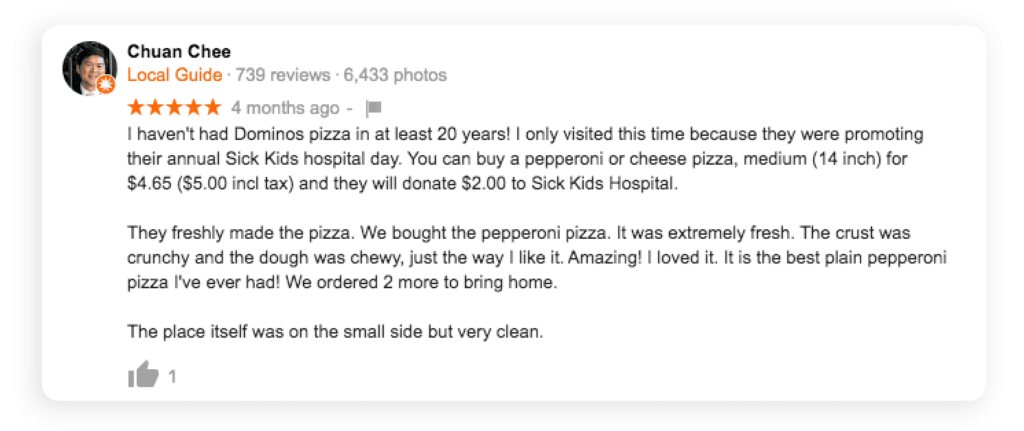
Which review is likely to influence someone with an intense pizza craving? A five-star rating and “good pizza” is not bad, but it doesn’t have the same impact. A review doesn’t have to be the length of War and Peace, but an honest, detailed, and specific recollection goes a long way to building credibility.
70% of U.S. consumers say they’ve spent more money to do business with a company that delivers excellent service. It’s not surprising then that a good review will shed a positive light on your customer experience.
An added bonus is if a review makes particular note of your staff or even calls out an employee by name:
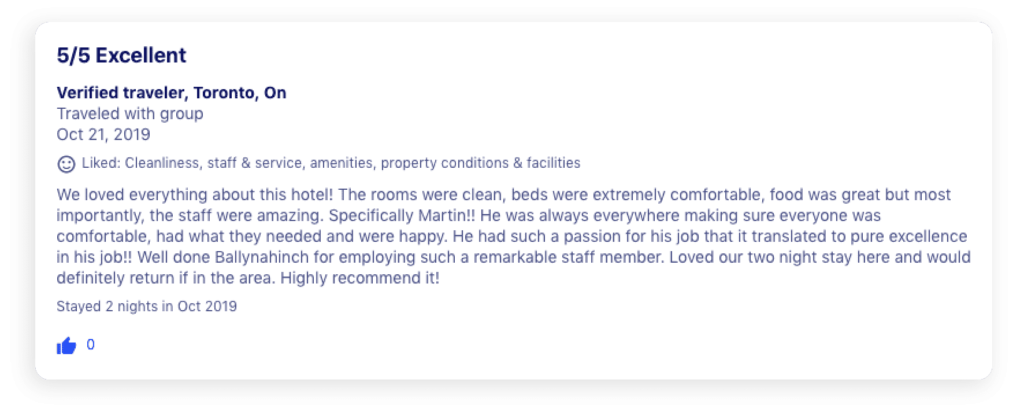
One less-heralded benefit of reviews is the feedback they provide you with. Ideally, a review also outlines areas of possible improvement. This constructive criticism is not only helpful to you. It also gives customers a sense of their “worst-case” scenario.
They want to know what can go wrong to understand just how much it will matter to them. Take this review:

If a customer doesn’t care about the restaurant’s food presentation, then it won’t bother them. If they do, and they decide to come anyway, then at least it won’t come as a surprise. Not only will they be less likely to complain, but they will also be more likely to focus on the positives they expected.
Marketers use a fancy word for images in reviews: User-generated content. If you are not a fan of marketing jargon, it basically means that your customers include pictures of your product in action or your business’s premise. These “real-life” images provide an in-depth and authentic feel to any review.
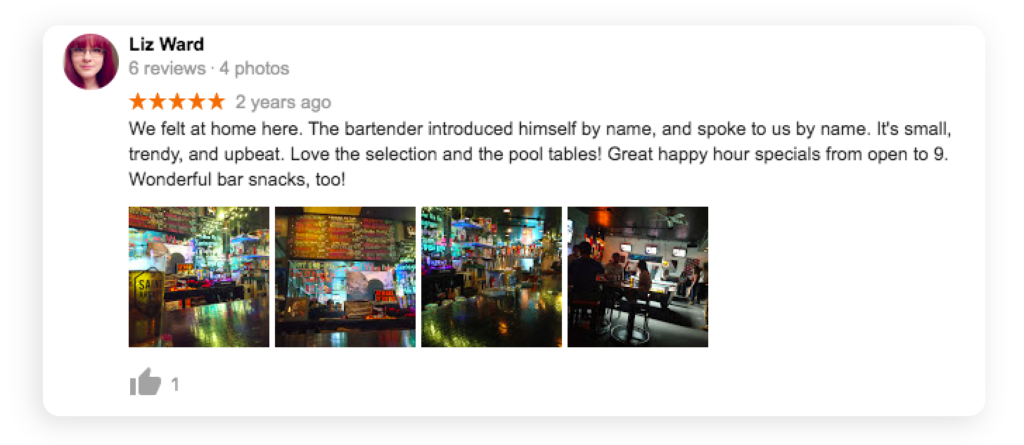

Now that you have a solid understanding of both the importance of good reviews and actual examples of real reviews, it’s time to focus on generating more of them.
There are a lot of different ways that you can help control the narrative in your reviews, but here are three critical areas you can’t ignore.
If you’ve paid attention thus far, you know that we already called out the importance of customer service. It might go without saying, but the number one way you can generate overwhelmingly positive customer reviews is by focusing on customer service.
Empower your staff to go above traditional standards—and beyond canned responses—to deliver personal customer support. A genuinely warm and human experience prompts loyalty like nothing else.

It’s incredibly rare that anyone would pick up the phone and call you up with feedback. Instead, your customers take to social media to talk about you. That’s why it’s essential to harness your most public-facing customer service touchpoint and join in on the conversation.
With the right approach, you can turn it into a goldmine of positivity. Encourage customer feedback and positive interactions with fun hashtags and quick responses, and most importantly, have fun.
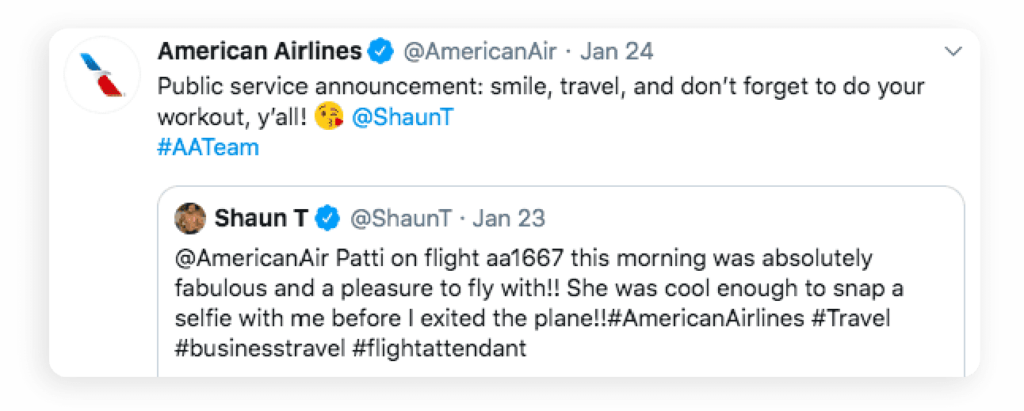
This does not apply solely to customers post-purchase, but at every single point on the customer journey. Your tone and voice in this interaction will help guide your customers, so expect it to be reflected back in their reviews.
Certain people believe that the higher-purpose of customer service is to turn an angry customer into a happy one. In this light, there lies an opportunity in every negative review.
While there is value in this, it can risk a mindset that ignores the power of good reviews too, and the need to respond to them. Positive reinforcement is the core concept here.
Happy customers need to be heard just as much as unsatisfied ones. This shows anyone thinking of leaving a review that they will be heard and that their feedback matters to you.
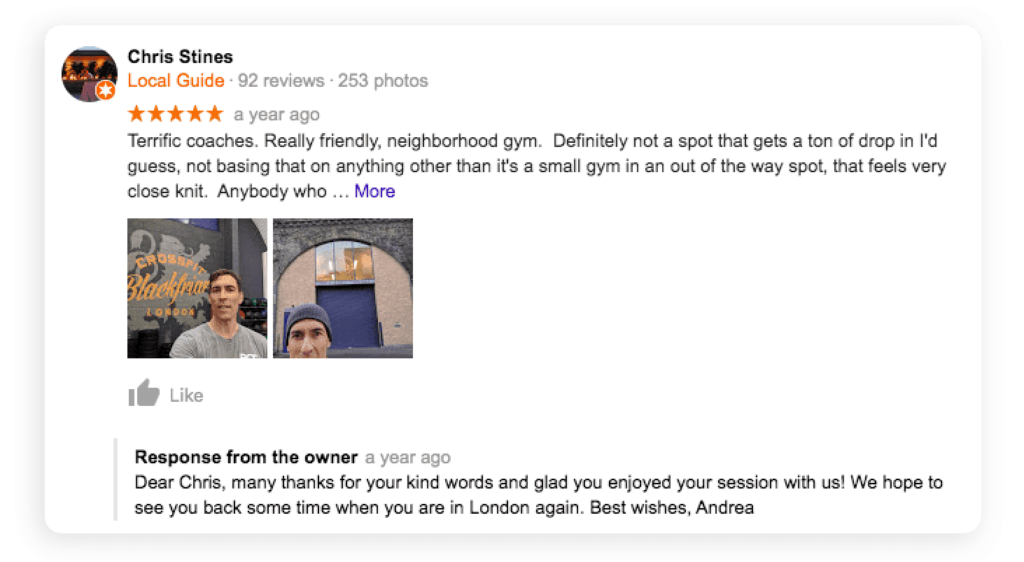
Whether you want to get reviews on Amazon or Facebook, repeat after me, “customer reviews are under my control.” Reviews are just another element of your company.
When you focus on excellent customer service, you create the reviews you want. You can also determine the tone and voice of the customer by reflecting it in your engagement with them, primarily in-person and through your social channels.
There is, unfortunately, no exact science. But when you see consistently excellent reviews roll in, you know you have the right formula.
Drew Wilkinson is the Head of Marketing at SimpleTexting. Drew has more than a decade of experience managing successful integrated marketing programs to build brands, raise awareness, and generate demand.
More Posts from Drew WilkinsonBuild an effective email marketing strategy in just a few simple steps with these tips and templates.
ReadSquarespace is one of the most user-friendly website builders out there. Here’s how to connect your Squarespace website with SimpleTexting so you can increase your marketing efforts with SMS.
ReadStart a text marketing campaign or have a 1-on-1 conversation today. It's risk free. Sign up for a free 14-day trial today to see SimpleTexting in action.
No credit card required